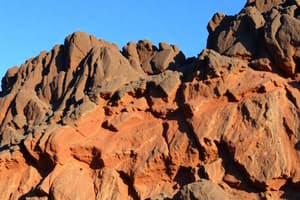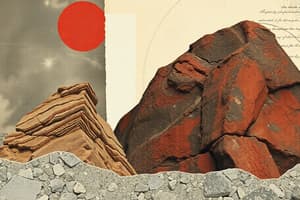Podcast
Questions and Answers
What process in the rock cycle forms igneous rock?
What process in the rock cycle forms igneous rock?
Cooling or crystallization
When it is beneath the earth's surface, molten rock is called what?
When it is beneath the earth's surface, molten rock is called what?
Magma
What general type of igneous rock has large grains?
What general type of igneous rock has large grains?
Intrusive
What happens to a rock when it undergoes melting in the rock cycle?
What happens to a rock when it undergoes melting in the rock cycle?
What feature does lava cooling quickly on Earth's surface give extrusive igneous rock?
What feature does lava cooling quickly on Earth's surface give extrusive igneous rock?
Explain the difference between a grain and a sediment.
Explain the difference between a grain and a sediment.
Describe granitic rock by naming two features and explaining what causes those features.
Describe granitic rock by naming two features and explaining what causes those features.
Name three igneous rocks.
Name three igneous rocks.
What two features can be used to classify igneous rocks as extrusive or intrusive?
What two features can be used to classify igneous rocks as extrusive or intrusive?
Explain why intrusive igneous rocks cannot have gas holes.
Explain why intrusive igneous rocks cannot have gas holes.
What process forms sedimentary rock by compressing sediment grains together?
What process forms sedimentary rock by compressing sediment grains together?
What forms sedimentary rock when water moves through and reacts with minerals?
What forms sedimentary rock when water moves through and reacts with minerals?
What forms when rocks are weathered and eroded?
What forms when rocks are weathered and eroded?
When sedimentary rocks form, which age of layers is found at the bottom?
When sedimentary rocks form, which age of layers is found at the bottom?
Rock and mineral fragments form which type of rock?
Rock and mineral fragments form which type of rock?
Minerals crystallizing from a water solution forms what type of rock?
Minerals crystallizing from a water solution forms what type of rock?
Name three sedimentary rocks.
Name three sedimentary rocks.
Explain why sedimentary rock can contain small pieces of other rocks or pebbles, but igneous rock can't.
Explain why sedimentary rock can contain small pieces of other rocks or pebbles, but igneous rock can't.
Describe how intrusive igneous rock becomes sedimentary rock.
Describe how intrusive igneous rock becomes sedimentary rock.
What are the three major types of rock?
What are the three major types of rock?
What process in the rock cycle forms metamorphic rock?
What process in the rock cycle forms metamorphic rock?
What process in the rock cycle causes metamorphic rock to become sediments?
What process in the rock cycle causes metamorphic rock to become sediments?
The composition of a metamorphic rock is determined by what?
The composition of a metamorphic rock is determined by what?
Foliated metamorphic rock has mineral grains that are like what?
Foliated metamorphic rock has mineral grains that are like what?
Nonfoliated metamorphic rock has mineral grains that are like what?
Nonfoliated metamorphic rock has mineral grains that are like what?
Name three metamorphic rocks.
Name three metamorphic rocks.
What can regional metamorphism create?
What can regional metamorphism create?
Use the following words in a complete and correct sentence: metamorphic rock, solid state, melting, plastic deformation.
Use the following words in a complete and correct sentence: metamorphic rock, solid state, melting, plastic deformation.
What two general characteristics do scientists use to classify rocks?
What two general characteristics do scientists use to classify rocks?
Label each arrow in the diagram with the correct process of the rock cycle.
Label each arrow in the diagram with the correct process of the rock cycle.
Flashcards are hidden until you start studying
Study Notes
Igneous Rocks
- Formation Process: Igneous rock is formed through cooling or crystallization of molten rock.
- Types:
- Intrusive rocks have large grains and form beneath the Earth's surface, allowing slow cooling.
- Extrusive rocks have small grains and form from lava that cools quickly on Earth's surface.
- Magma vs. Lava: Molten rock beneath the surface is called magma, while lava is the term for molten rock above the surface.
- Grains vs. Sediments: Grains are the individual particles of a rock, while sediments are loose fragments that have broken off from existing rocks.
Characteristics of Granitic Rock
- Granitic rock is typically light-colored and has a lower density due to its high silica content.
Common Igneous Rocks
- Examples: Gabbro, diorite, granite, basalt, rhyolite, pumice, obsidian.
Classification of Igneous Rocks
- Extrusive Features: Can contain gas holes and have small grains.
- Intrusive Features: Lack gas holes due to high pressure and have larger grains.
Formation of Sedimentary Rocks
- Processes:
- Compaction: Sediment grains are pressed together.
- Cementation: Minerals in water bind sediments to form rock.
- Sediment Formation: Occurs from weathering and erosion of rocks.
Sedimentary Rock Characteristics
- Layering: The oldest sedimentary layers are found at the bottom.
- Types:
- Clastic: Formed from rock and mineral fragments.
- Chemical: Formed through the crystallization of minerals from water solutions.
Common Sedimentary Rocks
- Examples: Conglomerate, limestone, sandstone, siltstone, claystone, gypsum, rock salt, coal.
Transition to Sedimentary Rock
- Sedimentary rock can incorporate small pieces of other rocks, while igneous rock cannot due to the melting process during formation.
Rock Cycle Dynamics
- Intrusive igneous rocks can transform into sedimentary rocks through weathering, erosion, compaction, and cementation.
- The three major types of rock are igneous, sedimentary, and metamorphic.
Metamorphic Rocks
- Formation: Result from increased temperature and pressure affecting existing rocks.
- Transformation Processes: Exposure leads to weathering and erosion, turning metamorphic rock into sediments.
- Composition: Determined by the mineral content of the parent rock.
Types of Metamorphic Rocks
- Foliated: Characterized by flat and elongated mineral grains in parallel layers (e.g., schist).
- Nonfoliated: Consists of interlocking mineral grains that are rearranged (e.g., marble).
Common Metamorphic Rocks
- Examples: Gneiss, slate, schist, marble, quartzite.
Regional Metamorphism
- Can lead to the formation of mountain ranges composed of metamorphic rock.
Classification Parameters
- Rocks are classified by texture (grain size in igneous rocks) and composition (minerals present influencing color and density).
Rock Cycle Processes
- Major processes in the rock cycle include melting, cooling or crystallizing, increased heat and pressure, weathering and erosion, compaction, and cementation.
Studying That Suits You
Use AI to generate personalized quizzes and flashcards to suit your learning preferences.




